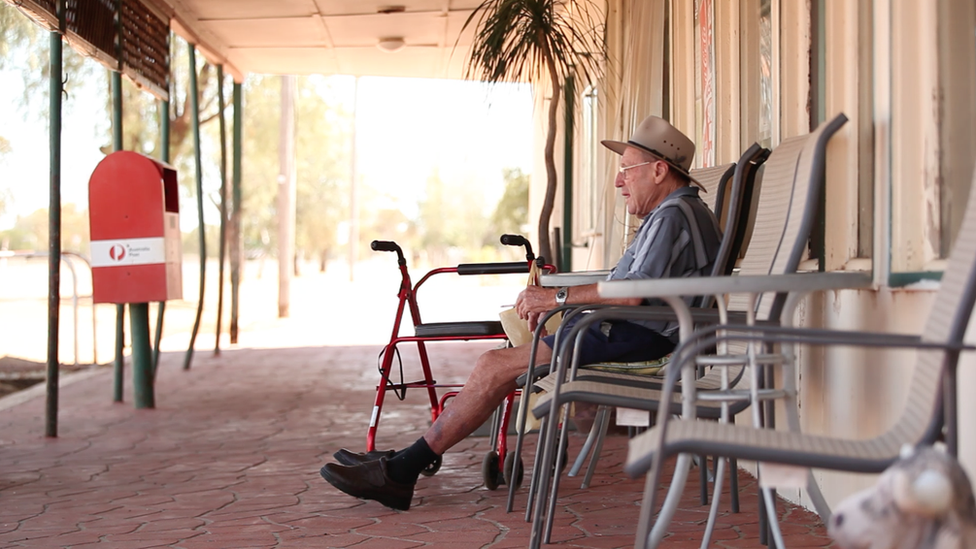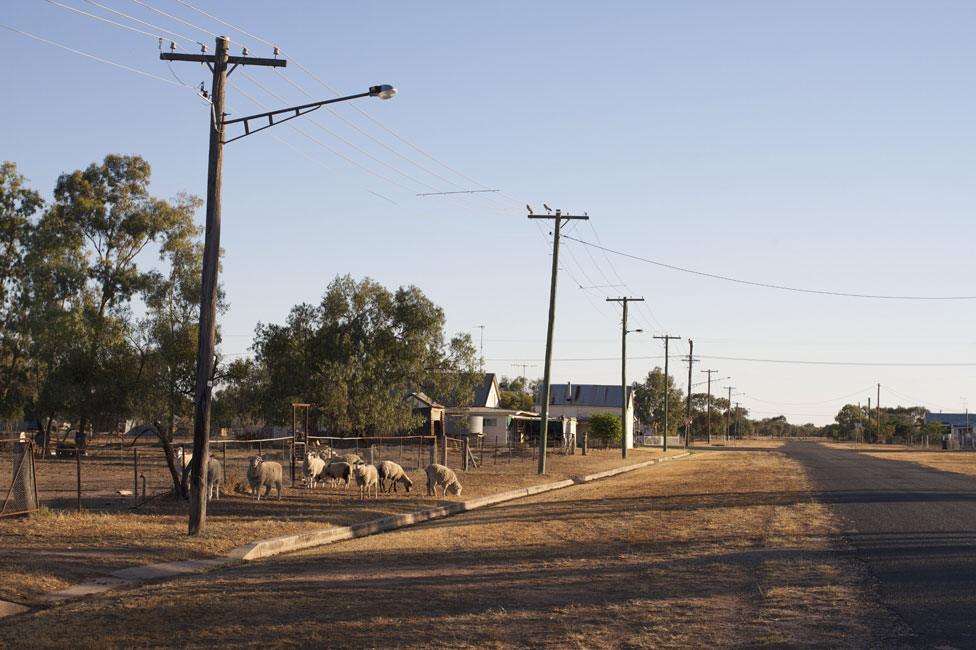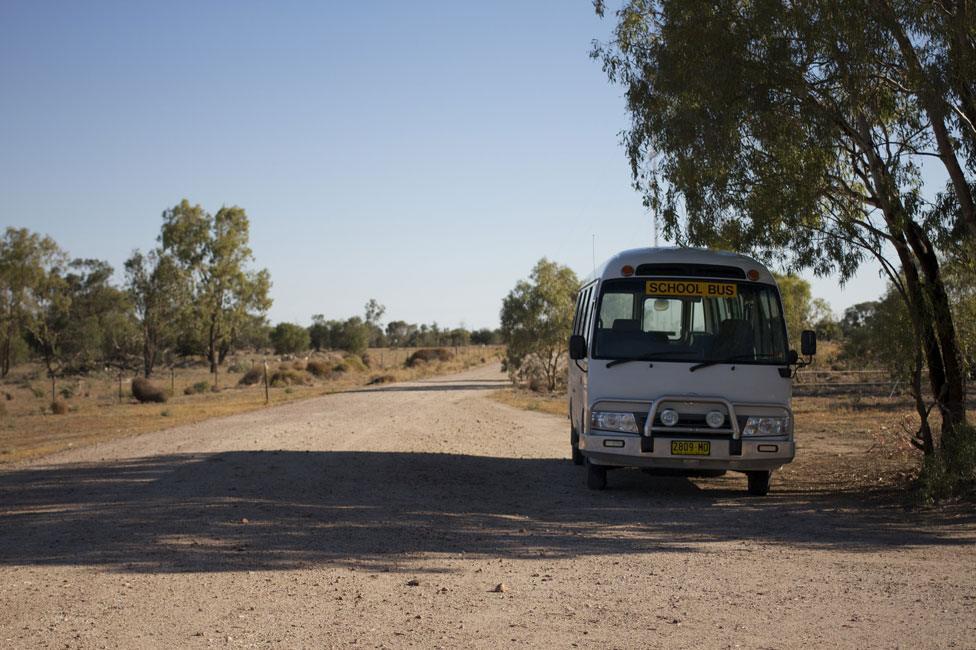Let's Dance: How Bowie played the outback
- Published
Can the David Bowie connection save the town of Carinda?
Three decades after David Bowie's worldwide hit Let's Dance, the remote Australian community where the video was shot is hoping its link with a pop icon will save it from extinction.
Feral pigs roam the outback surrounding the desert outpost of Carinda. Their carcasses - killed by hunters and discarded - greet visitors approaching via dirt roads.
The parched streets - once thoroughfares for the town's cotton industry - are deserted, and lined with For Sale signs. A decade of drought has made the place all but uninhabitable.
Yet this desolate place, with a population now of less than 40, holds a unique place in popular culture. It was here that in March 1983, a tanned David Bowie emerged reborn - after a decade of era-defining, sexually ambiguous personas - to shoot his comeback video, Let's Dance.
Peter Lawless, the shoot's location manager, remembers Carinda as "the closest thing we could find to a desert-like environment", with its nearby mountain range offering stunning, panoramic views, while the town itself felt untouched by the modern world.
"It was so alien for both sides, Bowie and the locals," he says.
"They didn't believe who he was. It was so off the wall. It was kind of weird."

Bernie Eccles featured in the video but had never seen it until now
John Swaffield, the focus puller, says that as well as those who did not recognise Bowie in the flesh, there were plenty who had no idea who - or what - had just inexplicably turned up.
"The music we were playing back then they hadn't even heard," he says.
Thirty years on, the Carinda Hotel, the focal point for that landmark clip, remains almost unchanged.
"When they rang up to make the arrangements, they didn't tell us who it was, so no-one expected it," says Lena Peacock, partner of the pub's then owner Ernie Robinson.
Robinson is one of those seen dancing in the video, while other townspeople prop up the bar. Most were "50-something old-timers", Swaffield remembers, because most of the youngsters were "off shearing".
One of them, Eric Amiet, who is known as "Bernie" or "Eccles", now aged 83, still lives in Carinda.
He recalls wanting to "have a look at him" when news of Bowie's arrival began to spread. He got there in the nick of time, and can be seen standing by the door.
He never saw the finished video, watched by millions when the song was released on 17 March 1983.
It followed a young Aboriginal couple, played by Joelene King and Terry Roberts, from Carinda to Sydney and back again.
"A direct statement on integration," was Bowie's own summary of the clip for ABC television.
Carinda, the singer had noted to Rolling Stone, was a place of "frankly brute character" that fascinated him as much as the rest of the vast, unforgiving continent - with its optimistic sense of 1950s-era America, and its shameful racist past. In the Let's Dance video that emerged, Bowie made direct references to domestic slavery, the Stolen Generation (the children taken away from Aboriginal families and put into care) and the British nuclear testing of the 1950s.

Let's Dance would go on to become Bowie's biggest-selling record, achieving mainstream success around the globe. At the time, the outback was fashionable - Fosters lager was being aggressively marketed in the UK and elsewhere, while Men at Work were riding high in the US and UK charts. The Let's Dance single - Bowie's only number one on both sides of the Atlantic - and the album, co-produced by Chic's Nile Rodgers, together sold in excess of 10 million copies worldwide.
Last year Bowie released another comeback disc - The Next Day - his most popular recording since Let's Dance. But Carinda, seemingly in terminal decline, is still looking for a way to reinvent itself.
Jayne Thomas, whose stepfather recently took over the lease of the Carinda Hotel, thinks Bowie could be the answer.
There are tentative plans, she says, to partner with a tour company located 150 miles south, to offer Bowie tours of the pub and the nearby Warrumbungle National Park, where some scenes of Let's Dance (and part of its follow-up, China Girl) were shot.
There's even talk of a Bowie festival, similar to the annual Elvis event held in Parkes - another drought-stricken country town, 200 miles closer to Sydney - which, now in its 21st year, attracts up to 15,000 visitors annually.
But it won't be easy.
"Everyone's selling up because of the drought," says Thomas.
After 10 dry years, there was some rain in 2010-11, but it had little lasting effect on Carinda.

"They don't know when the rain will come again," she says. "There's no work, no workers, no produce, no harvesters, nothing. The cotton gin used to have 40-50 people working in it and the town was booming. The pub and the [golf] club were open seven days a week. But the drought gutted everything. There were probably 400 people in the town and district. Now, most of them have gone."
Thomas admits the town does not currently have the infrastructure for tourists. The hotel is in dire need of renovation - the building is uninsurable, its wiring worn down, and its four rooms need upgrading.
The closest urban centre for visitors is 140 miles away - Coonabarabran, where Bowie and his 12-man crew stayed during the four-day shoot. (They had their sandwiches delivered from there by taxi, to the bemusement of the Carindans.)
The men who do visit tend to go pig hunting, Thomas says. "Other than David Bowie, there's not much else to draw people here."
But she remains cautiously optimistic.
"People still come in asking about the video," she says. "I'd like to have photos, information and the clip playing inside the pub, then go further and go year to year."
There may be life in the old town yet. Provided the rain comes.